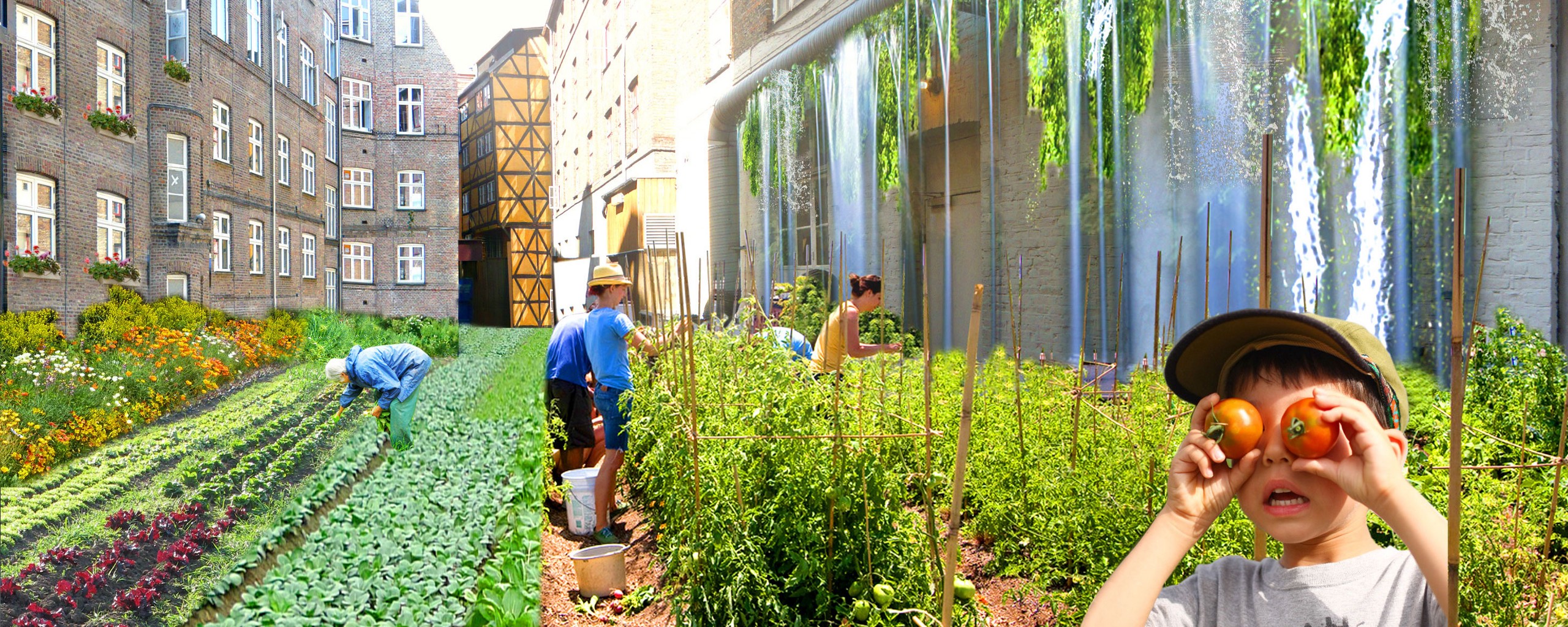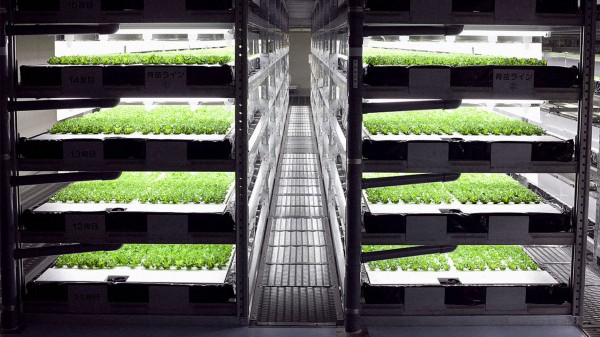
In a world of scarce resources, how do you feed a city of a million people–or even one of 10, 50, or 100 million? If you believe architects and designers, the answer lies in skyscraper farms, those futuristic structures overflowing with vegetation grown upwards in specialist pods. For industrialists, the solution is intense urbanization: Let people flock to and concentrate in cities, cover the countryside in ever-more sprawling farmland, and transport the food grown there to where people live.
Both are possible solutions to growing concerns about food security, but unless technology rapidly progresses, it’s flat farms that will continue to grow most of our food. And it’s safe to say that–legal restrictions aside–these industrial production centers will aim to maximize yield over almost any other concern. The health of humans, animals, and the environment will remain secondary priorities. Which presents us with a thornier challenge: Can you feed a large city–a mega-large city–and still make it healthy and sustainable?
The short answer, happily, is yes–though not in the way you might think. So far the conversation has centered around how to supply cities with enough food, sustainable or not. But the elephant in the room is that we need to fix our demand for cheap food–and, in particular, our insatiable hunger for animal products.
Essentially, it’s time for cities to talk about meat.
First, there’s the health issue. The average American wolfs down around 381 grams of meat a day–a mix of beef, pork, and poultry mostly, raised largely on industrial farms and fed a diet of grain that could have been eaten by humans. This isn’t representative of most of the world–the global average sits at around 173 grams, and a lot of that meat tends to come from small-scale farmers–but there is a clear trend. As we move from rural to urban zones and disposable incomes rise, we’re naturally inclined to maximize the protein-rich food in our diets.
In much of the world, this dietary shift is positive, making for healthier humans. But left unchecked, the newfound abundance of cheap meat comes at a great cost. The West is already eating too much for our bodies to handle. The highly processed meat on supermarket shelves has serious health implications, from associations with obesity to direct links with heart and bowel cancer. Last year, the World Health Organization made headlines when it declared red meat to be as likely carcinogenic as tobacco or asbestos. The United Nations has set a guideline upper limit of 70 grams of meat per day–a figure which has already been surpassed globally. Obesity is now considered a greater threat to public health than is hunger.
This is not just conjecture. A recent study from Oxford University modeled eating according to these guidelines and found it could save five million lives on health grounds alone by 2050. There is a clear public health imperative to change our attitudes about what we eat.
The second major issue is that what we eat has a big influence on climate change. Last year, a report by the Royal Institute for International Affairs made some blunt conclusions about the environmental need for addressing our impending food crisis. It found:
– Our appetite for meat is a major driver of climate change.
– Reducing global meat consumption will be critical to keeping global warming below the “danger level” of two degrees Celsius.
– Public awareness of the issue is low, and meat remains off the policy agenda.
– Governments must lead in shifting attitudes and behaviors.
The first two points are vital to (excuse the pun) digest–climate change and meat consumption cannot be viewed in isolation. The Royal Institute is not alone in making this conclusion. The Oxford University study predicted that simply limiting meat to recommended levels would reduce food-related greenhouse gas emissions by almost a third; completely abstaining would cut them by almost two-thirds.
But the greater part of the problem lies in the Royal Institute report’s final two points–that governments are failing to take the lead. The backlash that British Parliament member Kerry McCarthy received for her suggestion that “meat should be treated in exactly the same way as tobacco” demonstrates the taboo surrounding the meat industry. Nations are afraid of the repercussions that regulating or taxing meat will generate, so they don’t speak out about its dangers to our health or the planet’s. As a result, the issue rarely strays into the public consciousness, and thus little pressure is applied on governments to tackle it. The cycle of inertia means little gets done, but few people care.

This is where cities come into play. Obesity and climate change are two of the biggest challenges they’ll face in the 21st century. Ninety percent of urban areas are coastal, and their citizens will be the ones to feel the effects of rising sea levels and freak weather most deeply. So, too, will their health services and economies experience undue strain as the majority of their residents tip the scales and become overweight or obese. For cities, the consequences of inertia will be fatal.
But action must be born out of more than just necessity. Cities are also well placed to manage these changes. (The successes mayors have had in promoting activities like cycling, for instance–which also delivers enormous health and environmental benefits–is a testament to this.) The c40 Cities Climate Leadership Group, featuring 40 of the planet’s most influential cities, has claimed that city leaders have the flexibility which nation states lack: “City mayors are directly accountable to their constituents for their decisions, and are more nimble than state and national elected officials to take decisive action–often with immediate and impactful results.”
And this means they can interface with their citizens directly, getting to the root of problems and attitudes–the fact is, one study found that 90 percent of people’s justifications for eating meat boil down to it being “nice, necessary, normal, or natural.” Meanwhile, the majority of “meat-reducers” in the United Kingdom attribute the choice to improving their personal health–not animal welfare. Cities can move the debate beyond the ideological quagmire that governments, media, and activist groups are currently bogged down in.
From a warehouse in the center of Bristol, England, Steph Wetherell is setting up an alternative to supermarkets. The former farmhand helps run Real Economy, a food co-operative which collects produce from local, ethical suppliers and distributes it to groups across the city with almost zero markup in price.
“We’re cutting out the steps between the producer and consumer,” she explained. “So you know exactly what you’re getting when you shop. It’s not just a method of supplying cheap food–we’re trying to change the system and get people to engage with what’s on their plate. Education is a big part of what we do.”
The focus here is not on prescribing rules but encouraging a shift in culture–making sure the food is the best it can be. Though much of the co-op’s trade is plant-based, it is not meat-free. The red meat it offers is sourced from pasture-reared animals. These cattle are fed a traditional diet of grass, not grains, which can drastically reduces their environmental impact. According to Dr. Mark Eisler, a professor of food security at the University of Bristol, “a well-managed pasture acts as a carbon sink and actually puts carbon back into the soil.”
It’s one of just many schemes springing up in cities to make food consumption sustainable. But the real ingenuity lies in its financing: the co-op pays its suppliers in “Bristol Pounds,” a local currency designed to keep money from escaping the communities it serves. Each purchase of local produce encourages more money to be spent locally–instead of siphoned off by supermarkets. The project has received support from the city’s mayor, George Ferguson, for “strengthening our local economy by supporting local businesses.” The city-scale currency also encourages citizens to come into closer contact with those who supply their food.

The combination of local currency and ethically sourced farming is a novel idea. It marks a tentative reversal of the trend toward mass-produced, low-grade produce–where the gap between what someone grows and what we eat masks an unpalatable cocktail of human, animal, and environmental destruction. But decentralizing food supplies to improve its quality poses a new problem: making sure we have enough of that food to feed everyone.
This question of scale is important. Skyscraper farms present an optimistic vision of managing food supplies for a nation: The plans for a robot-run indoor farm in Kyoto, aiming to mass-produce 30,000 lettuces a day, show the quantity of produce that vertical farming technology can achieve without sacrificing environmental prosperity. Ninety-eight percent of the factory’s water will be recycled, no pesticides will be used, and the savings in labor costs allow the produce to be sold at prices equal to traditional outdoor farms.
But the financial returns on salad take a long time to pay off the costs of constructing a skyscraper. And, what’s more, it doesn’t address the underlying problem. As humans, we aren’t yet satisfied with lettuce–however much is being produced. Without a shift in attitudes, over-consumption of poor-quality meat will continue to plague us with health and environmental damage.
In Berlin, though, a more innovative take on the hydroponics technology behind skyscraper farms is taking off. Small vertical farms have been set up in supermarkets, which grow herbs directly where they’ll be purchased–eliminating the need for transport. These kräutergärten save on water, space, and energy in the same way that indoor farms in other parts of the world do. Nutrients and moisture are pumped directly to the plant under controlled lighting, allowing fresh fruit and vegetables to be produced all year round.
Though the pilot scheme currently only includes herbs and leafy greens, the technology is sound. There should be little difficulty in growing other foods, such as tomatoes or peppers, fresh for consumption in-store. As well as bringing consumers closer to their food, the scheme shows it’s possible to achieve considerable increases in sustainable food simply by using existing spaces more efficiently.
This is already happening. Instead of building up, hydroponic farming can also build out. In a former steel mill in Newark, New Jersey, shelves upon shelves of herbs and green vegetables are being grown to feed New York and New Jersey residents this spring. A vertical farm with a vengeance, its owners wish to “disrupt traditional supply chains by building farms on major distribution routes and near population centers.” By avoiding the expensive grandstanding of building an entire skyscraper, the farm should be able to supply two million pounds of greens annually by the end of the year.
But even this comes at a cost–Goldman Sachs has injected $39 million of investment into the project. And, as with Kyoto’s robot farm, it doesn’t solve the ravenous human demand for meat. This is why the fledgling schemes in Bristol and Berlin are so promising. We know technology can provide us with sustainable nutrition. Now we just have to choose to employ it.
This is key. Already, small steps are being taken across the planet to think differently about what we eat. Barcelona recently signed up for the Meat Free Monday campaign, joining cities such as New York and Vancouver in the fight to cut down on meat and encourage healthier eating. But too little is being done, and too late–without significant changes to our diets, expanding waistlines and noxious emissions will continue to harm our own health and the planet’s. Cities need to put meat reduction policies on the menu.


How We Get To Next was a magazine that explored the future of science, technology, and culture from 2014 to 2019. This article is part of our Metropolis section, on the way cities influence new ideas–and how new ideas change city life. Click the logo to read more.
